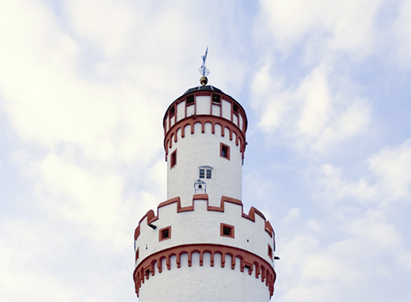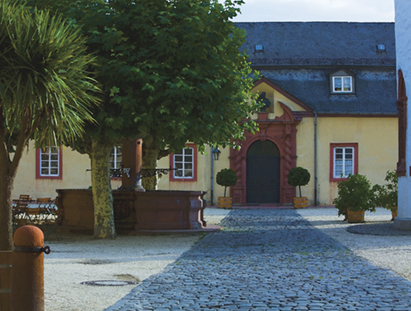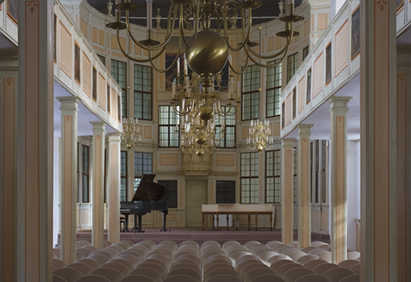|
The Buergy Organ The Great Buergy Organ of 1787 in Bad Homburg Castle Church dates back to those eventful times at the end of the 18th century. At that time, there lived in the little town of Homburg, seat of the Landgraves, a superb organ maker from Switzerland by the name of Johann Conrad Buergy (1721 - 1792). He received a commission from the Protestant-Lutheran Church Convent to build what was to be his greatest masterpiece. With 38 stops distributed over three manuals and pedals, this organ is a magnificent example of Central German organ building in the style documented as being preferred by Johann Sebastian Bach because of its distinctive sound. The effulgence of the organ takes on something of the Northern German tradition without neglecting the tonic keynotes found in Southern German organ building.
With its many registers, the organ offers a wide variety of wonderfully different sounds, ranging from exquisite solo voices of remarkable colour to a majestic tutti with striking bass tones. It is therefore equally suited to interpreting Baroque or Pre-Baroque works, classical compositions or selected pieces from the Romantic era, or indeed, even modern music. An unusual feature of the organ is its echo chamber: the wind chests and the pipes of this section of the instrument are hidden in the lower part of the organ housing, so that the tones are not directed straight into the church, but diverted though various byways, thus sounding remote and almost echo-like - an effect very popular in Baroque music, which was later continued with the remote consoles of Romantic organs.
The impressive sound is accompanied by opulent visuals: the artistic back-drop of pipes, which fills the entire rear space above the first gallery right up to under the church ceiling, forms a striking counterpart to the choir section facing it, framed by two rows of windows. These bathe the interior of the church in a warm glow of light that was nearly lost in the course of the changing history of the castle. For, with the dwindling influence of the Landgraves, the organ rapidly fell into disrepair. After only 90 years, its use was discontinued and it was later dismantled. All that remained were the housing and the bellows and - for a short time - the tin flue pipes, until these were melted down during the 1st World War. However, 200 years after its commemoration, two lucky coincidences made it possible to restore the organ to its original glory: Johann Conrad Buergy had a journeyman by the name of Johann Georg Foerster, who was to become one of the founders of Foerster & Nicolaus, the world-renowned and respected Hesse firm of organ builders.
Buergy's knowledge of the art of organ making has been handed down in this company until today. In the 1980s, the devoted citizens of Bad Homburg who were members of the Board of Trustees of the Bad Homburg Castle Church succeeded in having not just the church building restored to its original splendour, but the Great Buergy Organ of 1789 as well. And what could have been more natural than to entrust this demanding task to Foerster & Nicolaus, who duly completed it in 1989.
Today you can admire the organ in all its glory - as one of the few remaining testimonies to the style of organ building in the classical era. Its distinctive sound and remarkably broad range have been captured fully on the CD "Organ Gloriosa - In honour of the Prince of Homburg" for the very first time. More Photos of the Organ: |
|
Disposition of the Buergy Organ
|
|||||||||||||||||||||||||||||||||||||||||||||||||||||||||||||||||||||||||||||||||||||||||||||||||||||||||||||||||||||||||||||||||||||||||||||||||||||||||||||||||||||||||||||||||||||||||||||||||||||||||||||||||||||||||
|
Bad Homburg Castle It was thanks to Heinrich von Kleist's play "The Prince of Homburg" that the former residence of the Landgraves of Hesse-Homburg, a stone's throw away from the gates of Frankfurt, became world-famous. The palace with its wonderful gardens is probably one of the most beautiful baroque estates in Germany. It is therefore no wonder that the Prussian Kings and German Kaisers were very fond of spending the years between about 1866 and 1916 here. And also no doubt because of the relaxation and recreation provided by the town of Bad Homburg von der Höhe, a spa famous for its medicinal springs. Even the Prince of Wales used to come here in search of amusement, relaxation and "to take the waters" along with the English and Russian aristocracy.
At the courts of Europe, art was extremely multi-faceted. The educated aristocracy was aware of the necessity to support and cultivate the fine arts, and in doing so, created the basis for Europe's ambience. And so it was thanks to arts patron Isaak von Sinclair that the poet genius Friedrich Hölderlin became the court librarian at Homburg Palace during the artistically formative years of his short life. It was here that Hölderlin wrote "Patmos", probably his best-known poem. In those days, much that was of little ostensible or commercial value in the fine arts or in literature and music aroused considerable attention and admiration, thus laying the foundations of our cultural life and identity today.
Music that is new, pieces worth listening to and well worth conserving, little treasures from the traditional and the avant-garde - music that is unimaginable anywhere else but in the hotbed of Europe - our "Castle Concerts" series of recordings captures these in their original settings and preserves them for the future. By his endowment to the town church in Bad Homburg, Kaiser Wilhelm II unwittingly did the little church in the palace a favour and helped turn it into one of the most beautiful and intimate concert halls in Europe. The Palace Church fell into disuse and was forgotten, along with its magnificent late-18th century Bürgy organ. The turmoil and modernization fads of the 20th century passed it by, and it remained untouched until a local initiative, the "Bad Homburg Palace Church Trust", stepped in and secured enough patronage to save this architectural gem. True to the original and with a loving attention to detail, both church and organ were restored to create a truly wonderful concert hall.
Today the Palace Church sparkles with a renewed radiance that is set off perfectly by the superb "Music in the Castle" concerts organized with such enthusiasm by Ulrike and Volker Northoff. More information and the current concert dates at www.musik-im-schloss.de. |







